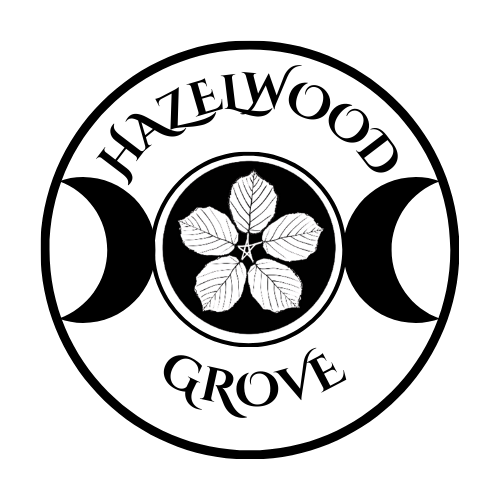Tinne- Holly
Physical/Practical
Holly, Ilex aquifolium is a small evergreen tree with glossy, spiny leaves that more often is seen as a shrub than a tree as they tend to grow fairly slowly. They have small white four petaled flowers which ripen into red berries. Most people are familiar with the appearance of holly because it is associated with winter holidays, though Christians are not the only ones to bring evergreen boughs into the home during the winter season. The sun-return has been celebrated at midwinter with evergreen holly and pine boughs representing vitality, renewal, and protection since neolithic times.
Magical/Lore
I associate Holly with the letter T, the third ogham along the top branch of the dolman. Tinne is a tree of defense and protection. Its spiny leaves ward off predators. It can be used not only for protection, but for help in the fight to maintain one's boundaries – sometimes it is necessary to take action by setting hard limits to overcome disputes and obstacles. When we are being treated indecently and unfairly, we become forced to take matters into our own hands to address a situation or person. Tinne teaches us that we must face confrontations with courage and honesty, and with the knowing that we may win or lose, but above all to maintain our limits with grace. When we are pushed and become angry, we must be careful not to overcorrect when we act out of hurt and cause undue harm to others. The other side of this of course is having too little defense of your limits, resulting usually from low self-esteem or a lack of knowing oneself and one's needs. Giving someone chance after chance when they repeatedly treat you poorly, disrespect you, your space and your time erodes your own self-respect and people who treat you this way don’t deserve limitless chances. The word tinne in Irish means ingot, a piece of metal that can be melted, poured and shaped into many things, armor or a weapon, for example. Tinne can help us learn the discipline to create the defenses needed to protect oneself.
Tinne is deeply rooted in ancient traditions, particularly the story of the Oak and Holly Kings. This enduring myth symbolizes the cyclical nature of life, death, and rebirth, intricately linked to the turning of the seasons. At the pivotal point of Midsummer, the Holly King ascends to his verdant throne, signifying the waning power of the sun and the gradual descent into the darker half of the year. In a powerful act of sacrifice, the Oak King is "killed," not in a literal sense of annihilation, but rather in a symbolic surrender of his reign, knowing he will return at Yule, the winter solstice, when the sun's return is celebrated and its light begins to strengthen once more. Together, these two powerful figures act as the vigilant guardians and devoted consorts of the Goddess, embodying the balance and interplay of light and shadow, growth and dormancy, life and regeneration.
This profound theme of seasonal sacrifice and symbolic death and rebirth is also seen in the medieval story of Gawain and the Green Knight. The enigmatic Green Knight, a figure of nature's untamed power, arrives at King Arthur's court, not with weapons of war, but bearing a formidable axe and a sprig of holly – a direct echo of the Holly King's association with midwinter and the coming darkness. He issues a challenge, a "beheading game" to any brave knight: to exchange blows, with the stipulation that the knight must allow the Green Knight to return the blow a year and a day later.
Sir Gawain, demonstrating his unwavering chivalry and courage, accepts this daunting challenge. He wields the axe and, to the shock and disbelief of the assembled court, severs the Green Knight's head. Yet, in a truly miraculous and unsettling display, the Green Knight simply picks up his own head, reiterates his promise to return, and calmly departs, leaving the court in a state of stunned silence.
True to his word, Gawain meets the Green Knight at the designated spot a year and a day later. Though he flinches from the first blow, a natural human reaction to impending doom, he gathers his resolve and holds steady for the subsequent strike. Ultimately, Gawain sustains only a minor wound to his neck, a mere scratch, and the beheading game concludes. The Green Knight, recognizing Gawain's bravery, integrity, and honor in facing the ordeal, proclaims him to be a blameless and exemplary knight.
Whether we examine the ancient archetypes of the Oak and Holly Kings, the steadfast Gawain, or other historical and mythological figures who engage in these "games of exchanging blows" or "beheading games," a crucial element emerges: sacrifice. It is imperative to remember that the word "sacrifice" originates from the Latin "sacrificium," meaning "to make sacred." On the surface, these narratives might appear to depict acts of violence or killing for their own sake. However, a deeper examination reveals a more profound truth.
In these symbolic encounters, the challenger, often a figure embodying nature's cyclical power or a magical being, is wounded but does not succumb to death due to their inherent magical nature. Simultaneously, the challenged individual who courageously faces their ordained comeuppance surprisingly walks away not only unscathed, but also profoundly transformed.
These "sacrifices" are not about senseless destruction; they are, in essence, initiations. They represent an ordeal, a trial that induces immense stress, challenges existing perceptions, and ultimately catalyzes significant personal change and growth. The "death" is symbolic, a shedding of the old self to make way for a new, more enlightened, and more honorable being. Through these ritualistic acts of "making sacred," individuals are affirmed and renewed, demonstrating that from what appears to be an ending, a new beginning truly emerges; this pattern can be seen all throughout the natural world.
Personal Experience
The first time I came in contact with a holly bush when I was learning the oghams over 10 years ago, I immediately got the message 'No. Not yet.' I wasn’t ready for its teachings, and it knew it. Now, over a decade later, I have a more profound understanding of the mysteries of Tinne.
Last year many of the lessons I had spent the last few years trying to unpack and understand culminated in an ordeal unlike any I have yet faced in my life. Standing up for myself, my truth, and my sovereignty lead to a complete and painful dissolution of the community that I had helped to found and build. I still cannot find the words to accurately depict the pain, betrayal and heartache wrought by this experience. I do however understand how necessary it all was, for all involved. The Hazelwood Collective had served its purpose; we had all gone as far as we could go with one another and the group had to disband because we had developed too many discordant frequencies which were no longer in energetic alignment with one another. Such is the nature of these groups. I didn’t want to see it or believe it, but it was time - beyond time - and the fall was out of my desperately grasping hands.
The night we all came together to collectively put our cards on the table felt very much like a beheading game, a night that I will likely never forget. All I could do is show up with my courage and integrity, to speak my truth regardless of the potential consequences, and to listen for the lessons and wisdom to be gained from what I now recognize was an ordeal, a trial, for all involved. Much was revealed, much was concealed, and still more was lost. Even in the midst of the fear, panic, and anger I realized this was an initiatory moment. A dark night of the soul for all involved. A precipice where the choices one makes can mean the difference between deep personal growth or stagnation; death. No matter what painful experiences life brings us to, we always have a choice to learn the lesson… or not.
Ultimately what got me through, and is still getting me through, is radical acceptance. Like Gawain accepting the return blow, like the Oak king choosing honor and accepting his duty to the cycle of life, death, and rebirth. Acceptance doesn’t make it okay, or mean that it won’t be difficult, or painful - these are the teachers - acceptance is the cessation of clinging to the desire for things to be different, to have gone differently. From there, learning, growth, and healing can occur. So I withdrew. I returned to my teachers, the trees. I held holly leaves, drew its oghamic symbol on my skin, carved it in candles, and meditated on depictions of holly from my tree ogham card deck, hoping to connect to the wise dyrads of Tinne to gain perspective and understanding regarding the ordeal that had transpired. I asked Tinne to aid me, to protect and defend me while I could not do so myself. I drank tea made from pine needles, beseeching Ailm for its perspective to help me achieve clarity. Every time I saw an oak tree, I wept for the loss of my king. I found it tempting to surround myself with thorny spiked leaves, never to let anyone past my defences ever again. I am still working with Tinne to learn appropriate defense of boundaries; it is a delicate balance that I one day hope to master.
The tight and contentious moments we experience in life are there to help initiate us. Several oghams hold various types of this energy for us. They can be useful allies when these moments occur in our life. If you are not yet ready to work with Holly, as I once was, I recommend Nion as an ally to early initiation, which can help guide you through difficult and transformative moments.
DIVINATORY MEANING
Sacrifice - Allow what is falling away to be sacred in its death.
Hardship - A call for courage and strength during contention, trials or ordeals.
Evergreen - Bring awareness to nurturing and supporting your own life-force during times of difficulty and chaos








